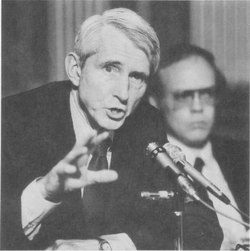Joseph Hendrie
Joseph Mallam Hendrie (born March 18, 1925) is a former chairman of the U.S. Nuclear Regulatory Commission (NRC).[2] On August 9, 1977 he was named to a four-year term on the Commission and designated as its chairman by President Jimmy Carter.[3] From 1975 to 1977, Hendrie had served as chairman of the Department of Applied Science at Brookhaven National Laboratory.[3]
Joseph Hendrie | |
|---|---|
 NRC Chairman Joseph Hendrie testifying at a hearing in 1979, following the Three Mile Island accident. | |
| Born | Joseph Mallam Hendrie[1] March 18, 1925 Janesville, Wisconsin, U.S. |
| Alma mater | Case Institute of Technology Columbia University |
| Occupation | physicist |
| Known for | Former Chairman of the United States Nuclear Regulatory Commission |
| Spouse(s) | Elaine Kostell[1] |
| Children | 2[1] |
Education and early career
Hendrie received a B.S. degree in Physics from Case Institute of Technology in 1950. He received a Ph.D. degree in physics from Columbia University in 1957.[3]
He worked at Brookhaven from 1955 to 1977.[3]
Three Mile Island accident
On March 28, 1979, the Three Mile Island nuclear plant, along the Susquehanna River located south of Harrisburg, Pennsylvania, suffered a partial meltdown. Although the meltdown was contained and radiation leakages were minimal, there were still worries that an evacuation would be necessary. Immediately following the accident, Hendrie advised Pennsylvania Governor Dick Thornburgh to order the evacuation "of pregnant women and pre-school age children ... within a five-mile radius of the Three Mile Island facility." Within days, 140,000 people had left the area.[4]
Fukushima reactors and accident
In the period when the GE Mark 1 commercial nuclear reactor designs were being installed and started up by Tokyo Electric Power Company at Fukushima, Japan, Hendrie addressed the design. "In 1972, Atomic Energy Commission safety official Stephen Hanauer recommended that the Mark I design be discontinued, arguing that the small containment design left it vulnerable to explosions from hydrogen buildup. At the time, soon-to-be-chairman of the [NRC ...] Hendrie said acceptance of the Mark I technology was so widespread that 'reversal of this hallowed policy, particularly at this time, could well be the end of nuclear power'."[5] In the Fukushima Daiichi nuclear disaster following the Tōhoku earthquake and tsunami in March 2011, Fukushima reactors saw several hydrogen explosions,[6] amongst other breakdowns.
Later career
Hendrie served as president of the American Nuclear Society 1984-85.[7]
References
- Works, United States Congress Senate Committee on Environment and Public (July 29, 1977). "Nominations: Hearings Before the Committee on Environment and Public Works, United States Senate, Ninety-fifth Congress, First Session, on the Nominations of Marian Edey to be a Member of the Council on Environmental Quality, William Drayton to be Assistant Administrator, Environmental Protection Agency, Kent Forrest Hansen, Joseph Mallam, and Peter Bradford to be Members of the Nuclear Regulatory Commission, July 18, 25 and October 6, 1977". U.S. Government Printing Office – via Google Books.
- Jimmy, Carter (January 1, 1977). Public Papers of the Presidents of the United States: Jimmy Carter, 1977. Best Books on. ISBN 9781623767662 – via Google Books.
- Dr. Joseph M. Hendrie, Chairman Profile, US Nuclear Regulatory Commission, August 1977 (Page Last Reviewed/Updated Thursday, March 29, 2012). Accessed February 28, 2010.
- A Decade Later, TMI's Legacy Is Mistrust The Washington Post, March 28, 1989, p. A01.
- Corbett, James, "Marks to Market: America’s Nuclear Time Bombs", BoilingFrogsPost.com via FukushimaUpdate.com, February 28, 2012. For the Hendrie quote, Corbett linked to a NY Times article dated 2011-03-16. Citation of the Times article, Hendrie's words and further design considerations also found at Bob Hennelly, "GE Design at Japan Nuclear Facility Found at Many Plants in U.S." Archived 2012-04-09 at the Wayback Machine, WNYC News, March 16, 2011. Retrieved 2012-08-09.
- "Hydrogen explosions Fukushima nuclear plant: what happened?" Archived 2013-12-02 at the Wayback Machine, hyer.eu.
- Presidents, American Nuclear Society webpage. Retrieved 2012-08-09.
Publication
- Hendrie, Joseph M., The future course of nuclear-power regulation, 1982. Pdf from Department of Energy.
External links
- Dr. Joseph M. Hendrie, Chairman Nuclear Regulatory Commission (Official site)